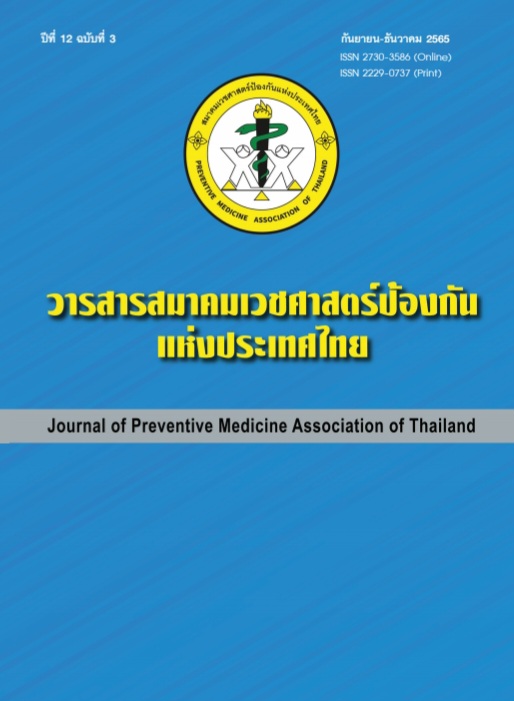The Development of a Clinical Supervision Model for Increasing The Efficiency of Nursing Care for Severe Sepsis Patients at Uthai Thani Hospital
Keywords:
Clinical Supervision, Severe Sepsis Patients, The Efficiency of Nursing CareAbstract
Objectives: To develop a clinical supervision model toward the improvement of efficiency in nursing patients with severe sepsis and to compare results of clinical supervision models among registered nurses before and after using the clinical supervision model toward the improvement of efficiency in nursing patients with severe sepsis.
Methods: This research was research and development. This was consists of 4 steps as follows: 1) Study the situation and the problem together with the study document analysis guide and literature. The instruments were (1) Voice recorders and notebooks (2) Documents and reports on nursing results of patients with severe septicemia; 2) Develop of a clinical supervision model for increasing the efficiency of nursing care for severe sepsis patients and try the model. The instruments were (1) Voice recorders and notebooks (2) study document analysis guide and literature; 3) Implement the clinical supervision model. 2 sets of instruments were (1) Clinical supervision model and (2) Data collection form (2.1) General information questionnaire of the sample group of registered nurses (2.2) Knowledge assessment form (2.3) Data collection form from the medical records of severe sepsis patients; 4) Study the results of using a clinical supervision model to increase nursing efficiency in patients with severe septicemia. The qualitative data in steps 1 and 2 were analyzed by content analysis and conclusions were drawn. Steps 3 and 4 analyzed quantitative data using descriptive statistics, paired t-test, and one sample t-test. The samples in this research were 24 register nurses in the internal medicine ward of Uthai Thani Hospital.
Results: It was found that a clinical supervision model for increasing the efficiency of nursing care for severe sepsis patients the main components of Procter's concept are as follows: 1) restorative clinical supervision, 2) formative clinical supervision, and 3) normative clinical supervision. And the clinical supervision model had a statistically significant effect on the nursing knowledge scores of patients with severe septicemia (p < .05). Clinical Supervision It was found that there was a statistically significant increase in the adherence to the guidelines for caring for patients with septicemia (p < .05) and a statistically significant increase in the attitude towards supervision scores. (p< .05)
Conclusion: The development of the clinical supervision model toward the improvement of efficiency in nursing patients with severe sepsis could increase knowledge and attitude toward the supervision among registered nurses and could increase the good results in nursing care for severe sepsis patients.
References
Rudd KE, Johnson SC, Agesa KM, Shackelford KA, Tsoi D, Kievlan DR, et al. Global, regional, and national sepsis incidence and mortality, 1990-2017: analysis for the Global Burden of Disease Study. Lancet 2020;395(10219):200-11.
กระทรวงสาธารณสุข. สถิติสุขภาพปี 2564. นนทบุรี: กระทรวงสาธารณสุข; 2564.
โรงพยาบาลอุทัยธานี. รายงานผลการดำเนินงาน 2564. อุทัยธานี: โรงพยาบาลอุทัยธานี; 2565.
Kumar A, Roberts D, Wood KE, Light B, Parrillo JE, Sharma S, et al. Duration of hypotension before initiation of effective antimicrobial therapy is the critical determinant of survival in human septic shock. Crit Care Med 2006;34(6):1589-96.
Rivers E, Nguyen B, Havstad S, Ressler J, Muzzin A, Knoblich B, et al. Early goal-directed therapy in treatment of severe sepsis and septic shock. N Eng J Med; 2001;345(19):1368-77.
Rhodes A, Evans LE, Alhazzani W, Levy MM, Antonelli M, Ferrer R, et al. Surviving sepsis campaign: international guidelines for management of sepsis and septic shock: 2016. Intensive Care Med 2017;43(3):304-77.
Levy MM, Evans LE, Rhodes A. The Surviving sepsis campaign bundle: 2018 update. Intensive Care Med 2018;44(6):925-28.
โรงพยาบาลอุทัยธานี. แนวทางปฏิบัติการดูแลผู้ป่วยติดเชื้อในกระแสโลหิต 2564. อุทัยธานี: โรงพยาบาลอุทัยธานี; 2565.
Proctor B. Training for the supervision alliance attitude, skills and intention. In: Butterworth TB, Cutcliffe JR, Proctor B, editors. Fundamental themes in clinical supervision. London: Routledge; 2001.
Crabtree BF, Miller WL. Doing qualitative research. CA: sage Publication; 1992.
รัชนีวรรณ คูตระกูล, พิชญพันธุ์ จันทระ, พัชรี ยิ้มแย้ม, สุรีย์พร กุมภาคา, รัชนี นามจันทรา. การพัฒนารูปแบบการนิเทศทางคลินิกการพยาบาลผู้ป่วยกลุ่มอาการติดเชื้อในกระแสเลือดชนิดรุนแรง. วารสารพยาบาลโรคหัวใจและทรวงอก 2562;30(2):193-209.
จีราพรรณ อันบุรี. ประสิทธิผลของการใช้แนวปฏิบัติ ทางการพยาบาลตามการบำบัดตามเป้าหมายตั้งแต่เริ่มแรกในผู้ป่วยติดเชื้อในกระแสโลหิตโรงพยาบาลกำแพงเพชร. [วิทยานิพนธ์พยาบาลศาสตรมหาบัณฑิต]. เชียงใหม่: มหาวิทยาลัยเชียงใหม่; 2555.
กรรณิกา อำพนธ์, ชัชญาภา บุญโยประการ, พัชรินทร์ ศิลป์กิจเจริญ. ผลลัพธ์ของการพัฒนาการดูแลผู้ป่วยติดเชื้อในกระแสเลือดโรงพยาบาลพระปกเกล้า. วารสารศูนย์การศึกษาแพทยศาสตร์คลินิก โรงพยาบาลพระปกเกล้า 2560;34(3):222-34.
ผ่องศรี สุวรรณพายัพ. การพัฒนารูปแบบการนิเทศทางการพยาบาลกลุ่มการพยาบาล โรงพยาบาลพระปกเกล้า. วารสารการพยาบาลและการศึกษา 2556;6(1):12-26.
Dellinger RP, Levy MM, Rhodes A, Annane D, Gerlach H, Opal SM, et al. Surviving sepsis campaign: international guidelines for management of severe sepsis and septic shock, 2012. Intensive Care Med 2013;39(2):165- 228.
เพ็ญศรี อุ่นสวัสดิพงษ์, กรองกาญจน์ สังกาศ, ศศิมา กุสุมา ณ อยุธยา, ยงค์ รงค์รุ่งเรือง. ผลของกิจกรรมพยาบาลมุ่งเป้าในระยะ 6 ชั่วโมงแรกต่อความรุนแรงของอวัยวะล้มเหลวในผู้ป่วยที่มีกลุ่มอาการ Sepsis. วารสารพยาบาลศาสตร์ 2554;29(2):102-10.
โรงพยาบาลอุทัยธานี. รายงานผลการดำเนินงาน 2565. อุทัยธานี: โรงพยาบาลอุทัยธานี. 2566
Downloads
Published
How to Cite
Issue
Section
License
Copyright (c) 2023 Journal of Preventive Medicine Association of Thailand

This work is licensed under a Creative Commons Attribution-NonCommercial-NoDerivatives 4.0 International License.
บทความที่ลงพิมพ์ในวารสารเวชศาสตร์ป้องกันแห่งประเทศไทย ถือเป็นผลงานวิชาการ งานวิจัย วิเคราะห์ วิจารณ์ เป็นความเห็นส่วนตัวของผู้นิพนธ์ กองบรรณาธิการไม่จำเป็นต้องเห็นด้วยเสมอไปและผู้นิพนธ์จะต้องรับผิดชอบต่อบทความของตนเอง






